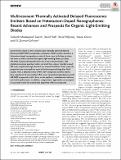Files in this item
Multiresonant thermally activated delayed fluorescence emitters based on heteroatom doped nanographenes : recent advances and prospects for organic light-emitting diodes
Item metadata
| dc.contributor.author | Madayanad Suresh, Subeesh | |
| dc.contributor.author | Hall, David | |
| dc.contributor.author | Beljonne, David | |
| dc.contributor.author | Olivier, Yoann | |
| dc.contributor.author | Zysman-Colman, Eli | |
| dc.date.accessioned | 2020-05-28T11:30:56Z | |
| dc.date.available | 2020-05-28T11:30:56Z | |
| dc.date.issued | 2020-08-12 | |
| dc.identifier | 267127632 | |
| dc.identifier | 1d121898-cdd9-4e8c-8039-44ab7fb2b6e7 | |
| dc.identifier | 85085590830 | |
| dc.identifier | 000535648400001 | |
| dc.identifier.citation | Madayanad Suresh , S , Hall , D , Beljonne , D , Olivier , Y & Zysman-Colman , E 2020 , ' Multiresonant thermally activated delayed fluorescence emitters based on heteroatom doped nanographenes : recent advances and prospects for organic light-emitting diodes ' , Advanced Functional Materials , vol. 30 , no. 33 , 1908677 . https://doi.org/10.1002/adfm.201908677 | en |
| dc.identifier.issn | 1616-301X | |
| dc.identifier.uri | https://hdl.handle.net/10023/20004 | |
| dc.description | We thank the Leverhulme Trust (RPG-2016-047) for the financial support. S.S. acknowledges sup-port from the Marie Skłodowska-Curie Individual Fellowship (NarrowbandSSL EC Grant Agree-ment No: 838885). Computational resources have been provided by the Consortium des Équipements de Calcul Inten-sif (CÉCI), funded by the Fonds de la Recherche Scientifiques de Belgique (F.R.S.-FNRS) under Grant No. 2.5020.11, as well as the Tier-1 supercomputer of the Fédération Wallonie-Bruxelles, infrastructure funded by the Walloon Region under the grant agreement n1117545. DB is a FNRS Research Director. | en |
| dc.description.abstract | Since the first report in 2015, multiresonant thermally activated delayed fluorescent (MR‐TADF) compounds, a subclass of TADF emitters based on a heteroatom‐doped nanographene material, have come to the fore as attractive hosts as well as emitters for organic light‐emitting diodes (OLEDs). MR‐TADF compounds typically show very narrow‐band emission, high photoluminescence quantum yields, and small ΔE ST values, typically around 200 meV, coupled with high chemical and thermal stabilities. These materials properties have translated into some of the best reported deep‐blue TADF OLEDs. Here, a detailed review of MR‐TADF compounds and their derivatives reported so far is presented. This review comprehensively documents all MR‐TADF compounds, with a focus on the synthesis, optoelectronic behavior, and OLED performance. In addition, computational approaches are surveyed to accurately model the excited state properties of these compounds. | |
| dc.format.extent | 25 | |
| dc.format.extent | 7935656 | |
| dc.language.iso | eng | |
| dc.relation.ispartof | Advanced Functional Materials | en |
| dc.subject | Multiresonance | en |
| dc.subject | Organic light-emitting diodes | en |
| dc.subject | Thermally activated delayed fluorescence | en |
| dc.subject | QD Chemistry | en |
| dc.subject.lcc | QD | en |
| dc.title | Multiresonant thermally activated delayed fluorescence emitters based on heteroatom doped nanographenes : recent advances and prospects for organic light-emitting diodes | en |
| dc.type | Journal item | en |
| dc.contributor.sponsor | The Leverhulme Trust | en |
| dc.contributor.sponsor | European Commission | en |
| dc.contributor.institution | University of St Andrews. School of Chemistry | en |
| dc.contributor.institution | University of St Andrews. EaSTCHEM | en |
| dc.identifier.doi | https://doi.org/10.1002/adfm.201908677 | |
| dc.description.status | Peer reviewed | en |
| dc.date.embargoedUntil | 2020-05-27 | |
| dc.identifier.grantnumber | RPG-2016-047 | en |
| dc.identifier.grantnumber | 838885 | en |
This item appears in the following Collection(s)
Items in the St Andrews Research Repository are protected by copyright, with all rights reserved, unless otherwise indicated.

